While you may be able to grow an apple or pear tree in your backyard, unless you live in a warm climate, you can’t grow most tropical fruit at home. At least, that was the case before some inventive gardeners and plant nursery workers started to selectively cultivate dwarf fruit trees.
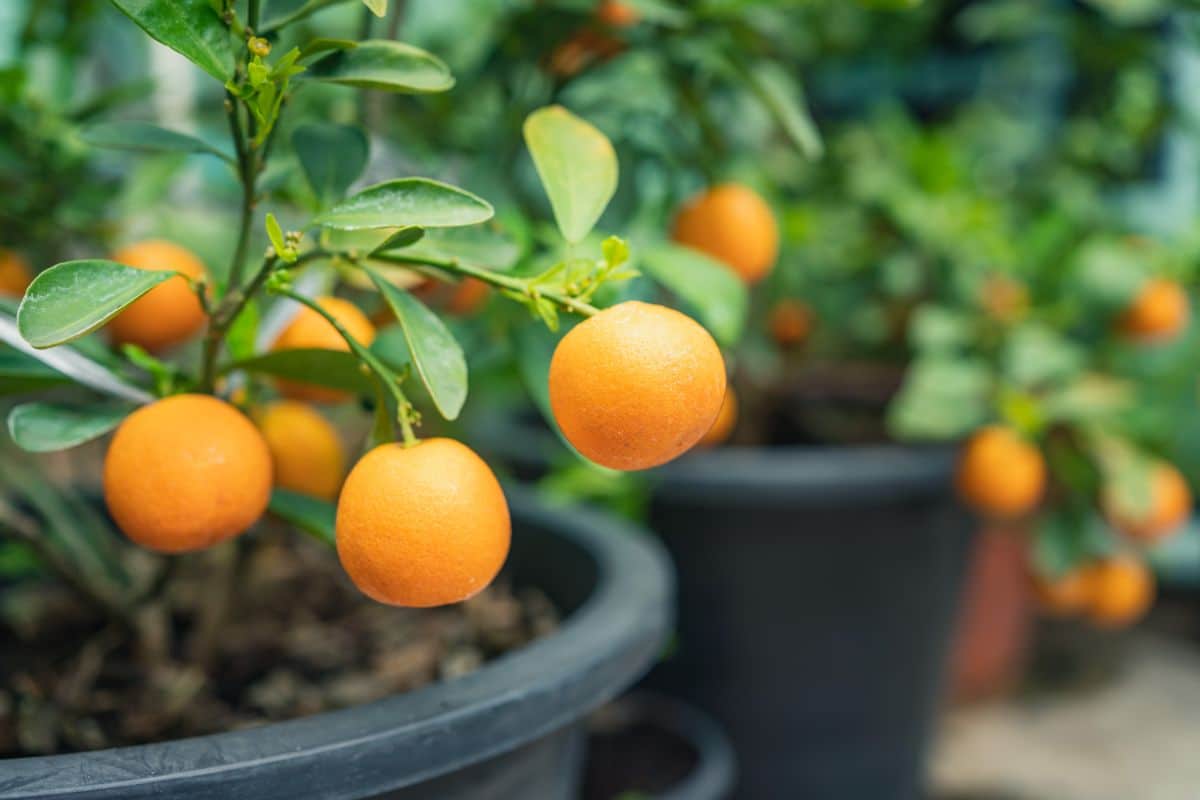
Today, there are actually a number of mini tropical fruiting trees that can be grown in your home. These pint-sized plants are relatively easy to keep and can produce a bountiful harvest of delicious fruity flavors. What’s more, when kept inside, some of these plants will even fruit in winter, which can help brighten up your indoor space even when it’s snowing.
In this article, we’ll examine some of the best mini fruit trees that can be kept in your home. We’ve also included some helpful growing tips, so you grow the most productive trees around.
Jump to:
12 best mini fruit trees to grow indoors
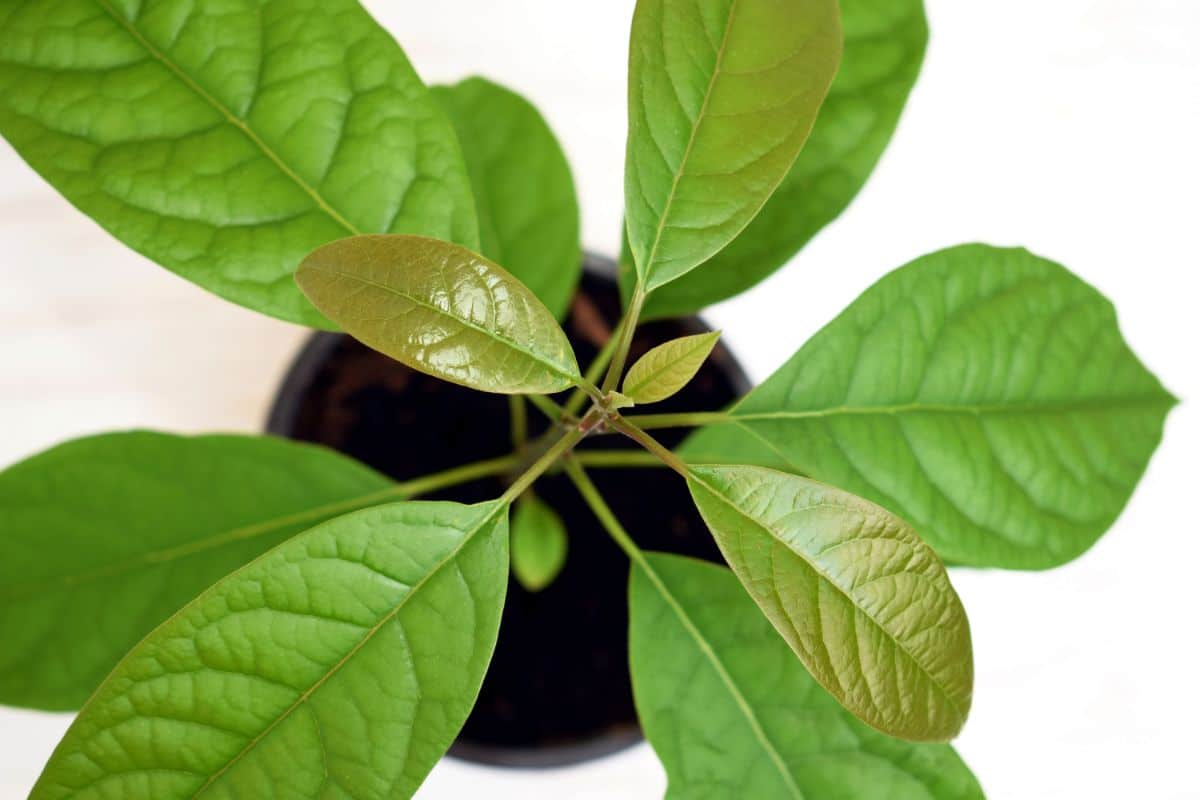
Due to their small size and ease of keeping in containers, dwarf varieties are the best types of fruit trees to grow indoors. Below are some of the top mini trees to keep inside for delicious, tropical fruit year round!
1. Meyer lemon

| Plant name: | Meyer lemon |
| Lighting requirements: | Bright light |
| Watering requirements: | Moderate |
| Fruiting time: | Year-round, harvest are more abundant from November through March |
| Growing zone: | Zones 8 to 11 |
Meyer lemons are sweeter than standard storebought lemons, but you’re unlikely to find them in grocery stores because their soft skin makes them difficult to store and ship. Growing your own Meyer lemons indoors will make sure you have plenty of tasty lemons to use for desserts and other dishes. And, of course, Meyer lemons are known for making some of the tastiest lemonade.
Dwarf Meyer lemons are some of the easiest citrus trees to keep indoors in pots. While they do require bright light, they don’t need quite as much humidity as some other fruiting trees. They also stay small, maxing out at about 4’ in height.
2. Kumquat
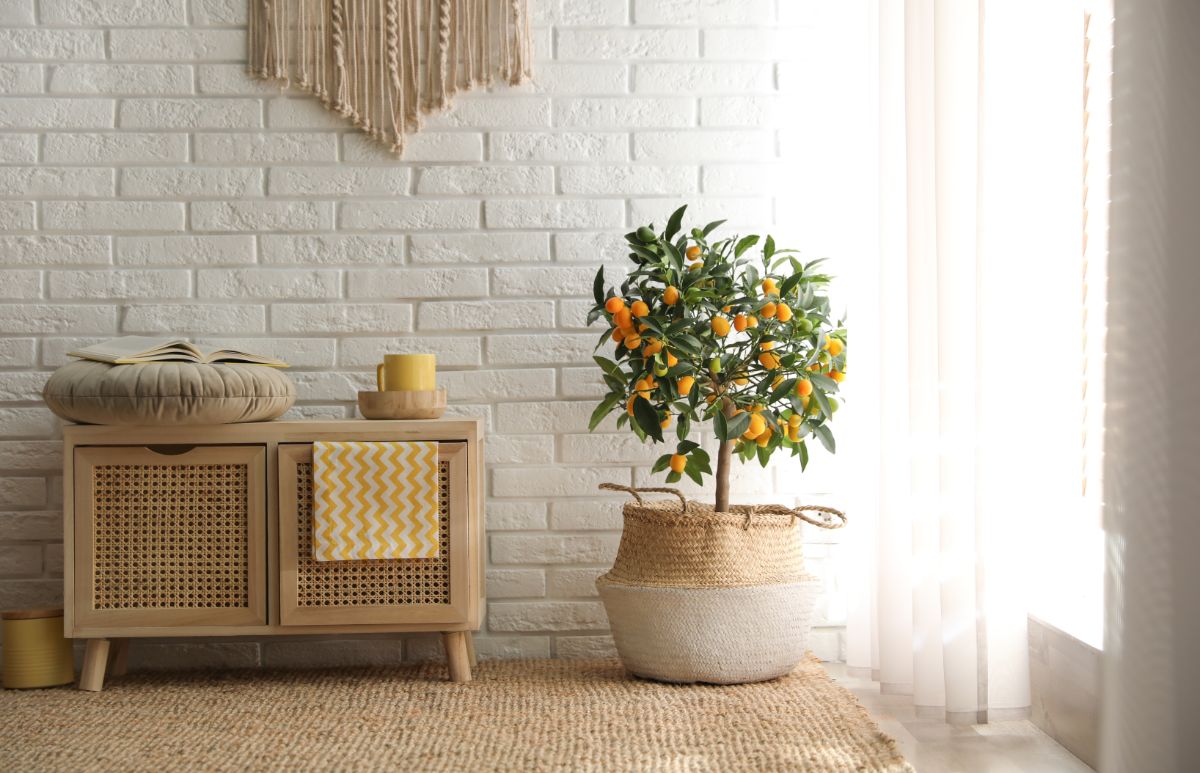
| Plant name: | Kumquat |
| Lighting requirements: | Bright light |
| Watering requirements: | Moderate |
| Fruiting time: | December through March |
| Growing zone: | Zones 9 to 10 |
A less well-known type of citrus, kumquats look like tiny oranges, but they pack a punch. While the sour fruit may make your mouth pucker when you eat them raw, kumquats can be baked into bread and desserts or added to chutneys, jellies, and marmalades. Unlike other citrus fruit, kumquats have sweeter skin, while the interior of the fruit is the tangiest part!
Dwarf kumquat trees grow to about 6’ high, but they should be pruned to keep them from getting overgrown. These plants are also available in both standard green and variegated options, which have very pretty, mottled green and white leaves. Kumquats bloom small, white, and highly fragranced flowers that mature into fruit in late winter to early spring.
3. Avocado
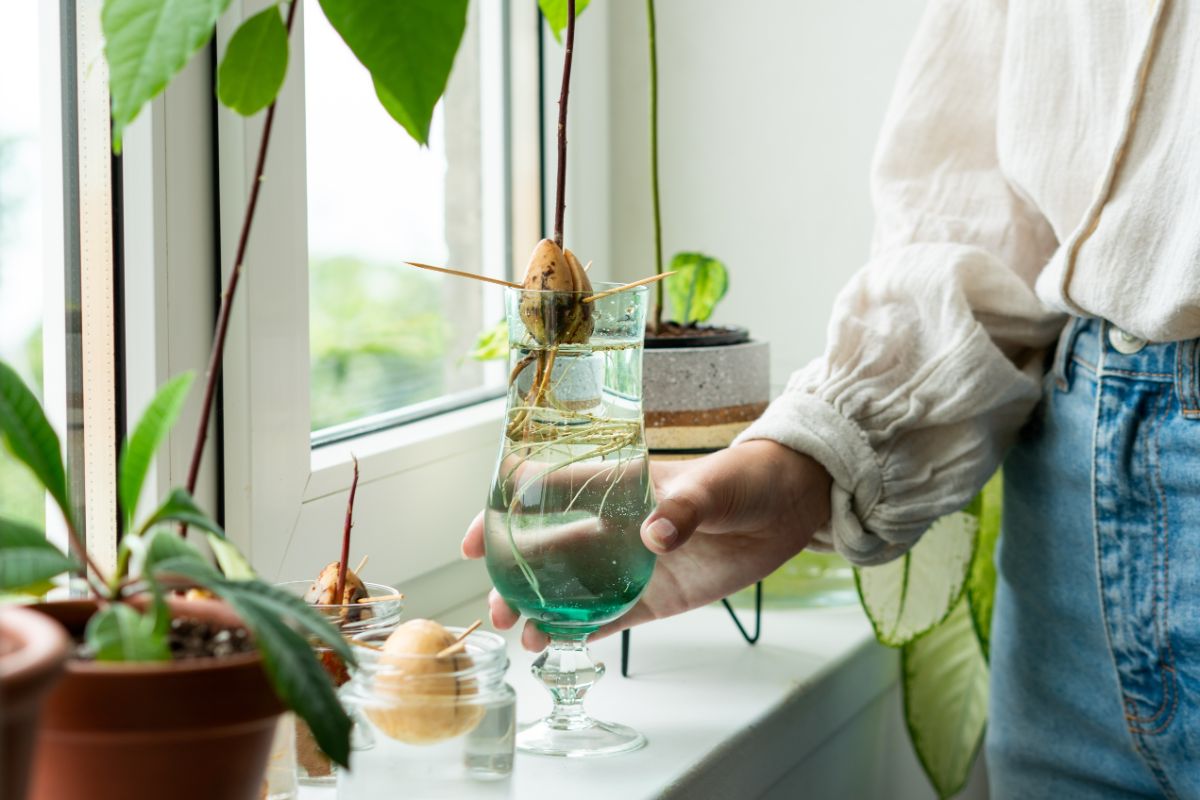
| Plant name: | Avocado |
| Lighting requirements: | Bright light |
| Watering requirements: | Moderate |
| Fruiting time: | Year-round |
| Growing zone: | Zones 9 to 11 |
Many houseplant keepers grow their own avocado trees from the pits of avocados they buy at the grocery store. While these plants are attractive and relatively easy to maintain, they very rarely produce fruit.
If you are set on growing avocado fruit indoors, opt for grafted avocado trees rather than plants grown from pits. The cultivars ‘Gwen’ and ‘Whitesell’ usually are best for indoor growing, and they don’t need to be pollinated by insects.
Avocado trees should be watered regularly, and drooping leaves signal that your plant needs more moisture. Provide your mini tree with plenty of bright light, and consider adding a pebble tray beneath your plant for a bit of extra humidity.
4. Calamondin orange

| Plant name: | Calamondin orange |
| Lighting requirements: | Bright light |
| Watering requirements: | Moderate |
| Fruiting time: | Year-round |
| Growing zone: | Zones 8 to 11 |
Standard orange trees generally aren’t the best picks for indoors, but Calamondin oranges are well-suited for container growing. Produced by crossing kumquats and oranges, this fruiting tree stays smaller but will branch more with frequent pruning. The fruit has a nice, tangy flavor and makes a wonderful marmalade.
Fragrant, white flowers mature into Calamondin oranges, while the fruit can hang on the plant for several months for a spectacular indoor display. Like other citrus plants, these trees do best with higher than average indoor humidity – 50% or higher. They are also quite resistant to indoor pests, although they can be affected by mealybugs, scale, and mites.
5. Olive
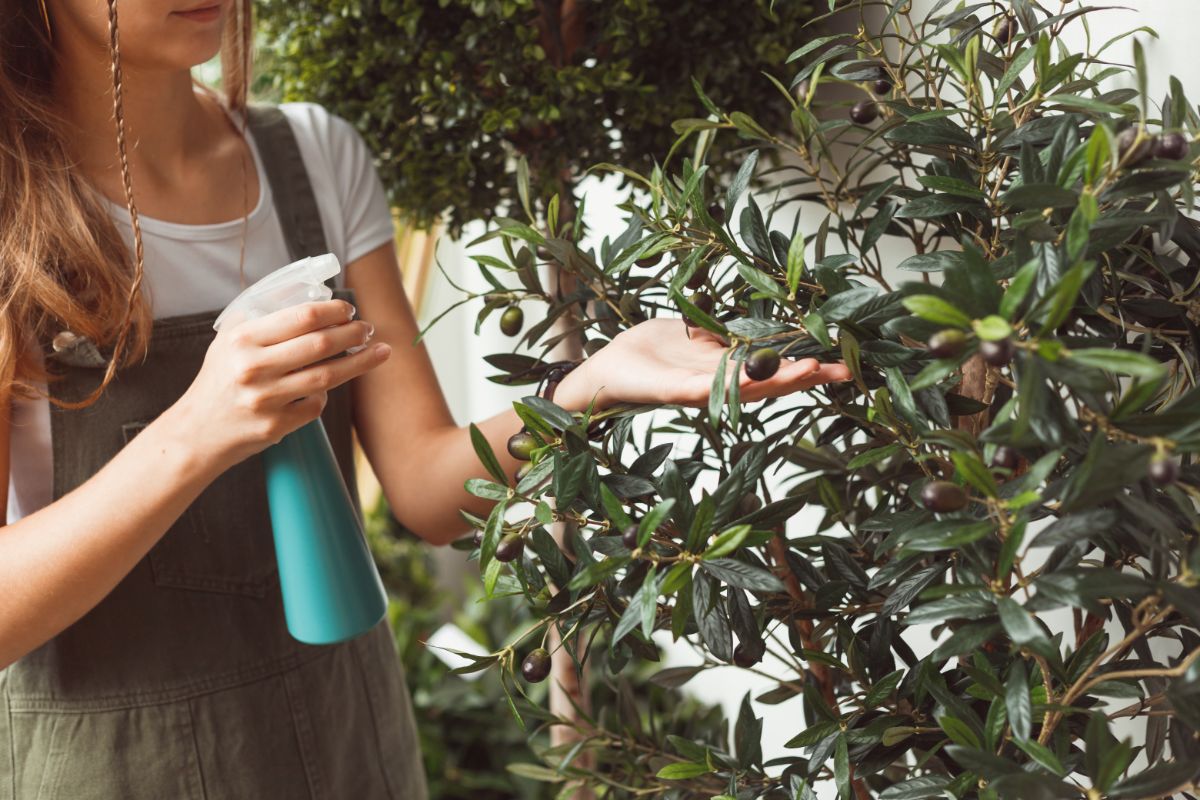
| Plant name: | Olive |
| Lighting requirements: | Bright light |
| Watering requirements: | Moderate |
| Fruiting time: | August through November |
| Growing zone: | Zones 10 to 11 |
Olive trees are gorgeous plants with fine and delicate leaves that seem to glow when backlit by the sun. As pretty as they are, not all olive trees fruit, so be sure you know what cultivars do. For indoor growing, ‘Arbequina’ and ‘Picholine’ are fine picks that produce reliably, even when grown in pots.
Olive trees can be easier to grow than some other fruit trees. They can tolerate dry soil a bit better than some other tropical species, but they should still be watered when the top 1 to 2” of soil is dry to the touch. Watering can be reduced somewhat in fall and winter when the tree isn’t actively growing.
6. Fig
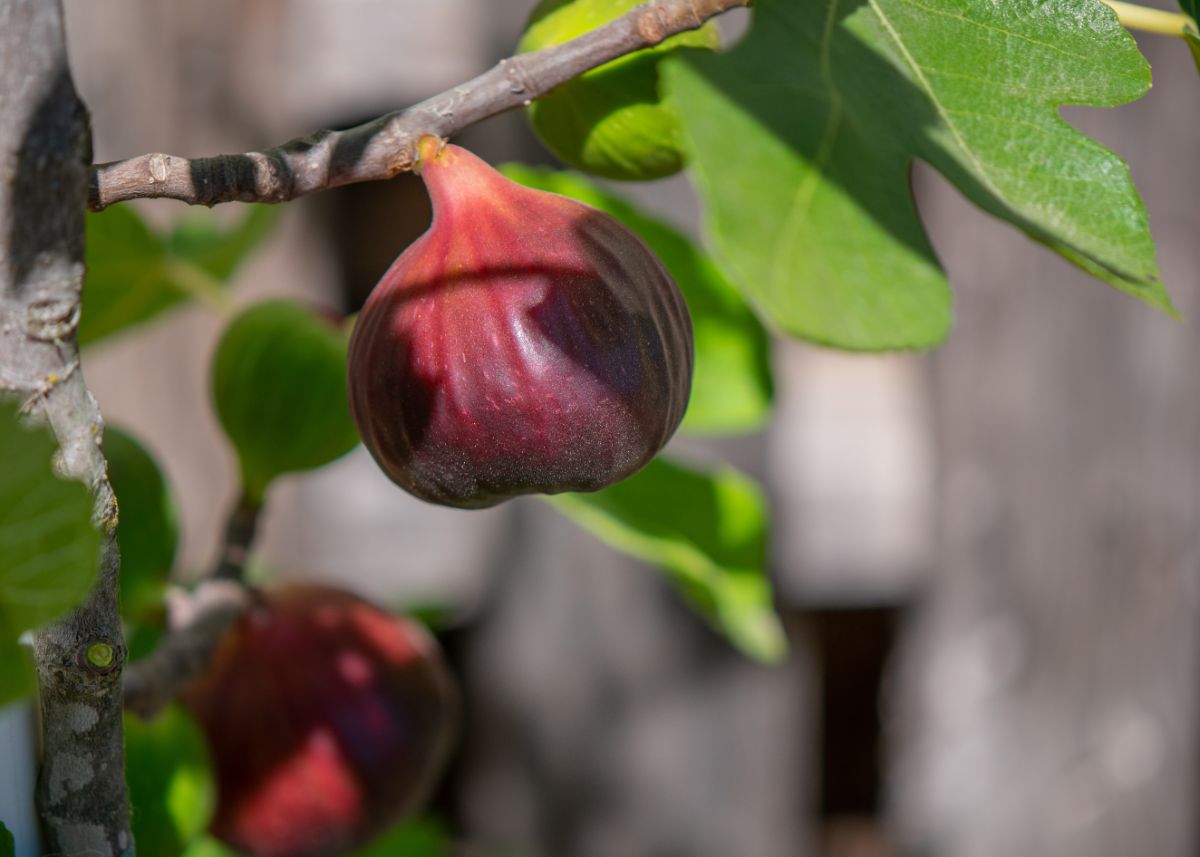
| Plant name: | Fig |
| Lighting requirements: | Bright light |
| Watering requirements: | Moderate |
| Fruiting time: | May through November |
| Growing zone: | Zones 7 to 10 |
Houseplant keepers are well aware of ornamental figs like the fiddleleaf fig and the weeping fig; however, if you want to grow fruit indoors, these aren’t the figs for you. While these plants make attractive ornamental specimens, they don’t produce edible fruit. Instead, opt for dwarf fruiting fig cultivars like ‘Brown Turkey.’
This fig type produces mouthwateringly sweet figs that are wonderful fresh or, when cooked into desserts, syrups, and other dishes. It also tolerates pruning well and is self-pollinating, making it an ideal addition to indoor growing spaces. As figs can benefit from extra humidity, you may want to add a humidifier near your plant.
Keep in mind that pot size can influence your fruiting trees. For more fruit, choose a larger pot; however, if you want your plant to remain compact, smaller pots are best.
7. Mulberry
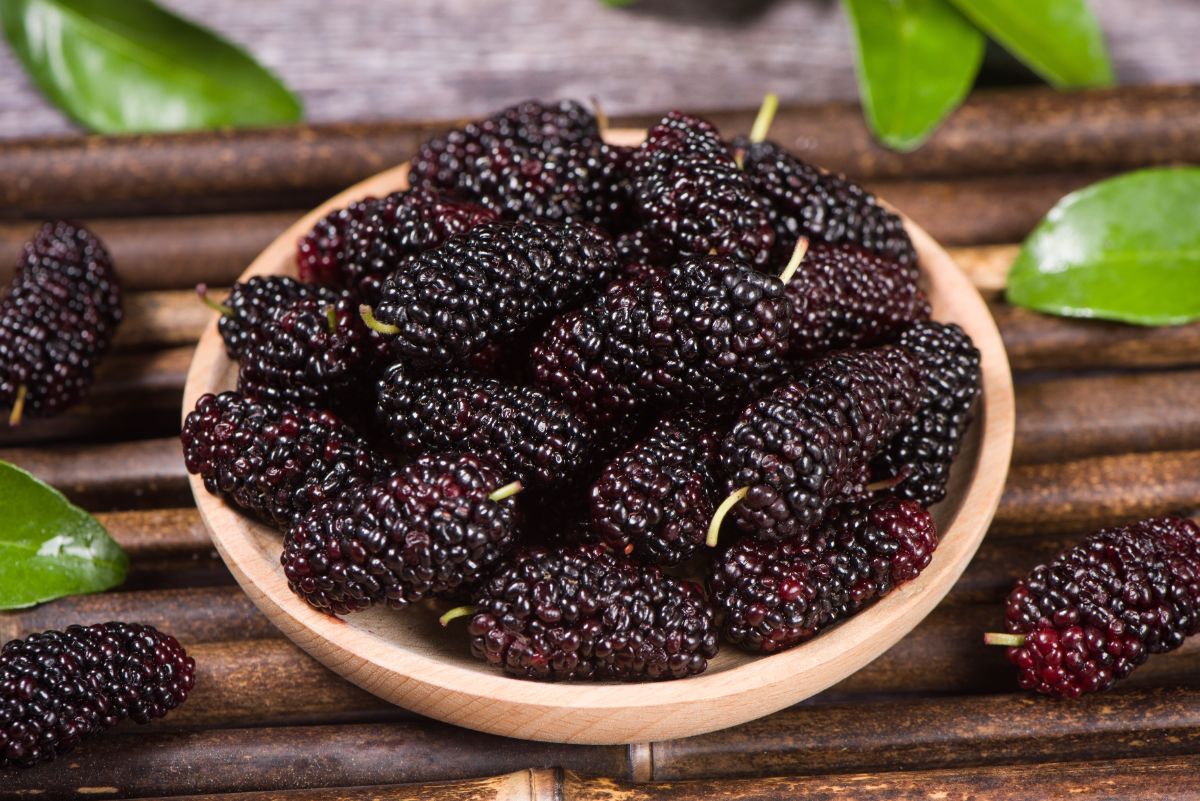
| Plant name: | Mulberry |
| Lighting requirements: | Bright light |
| Watering requirements: | Moderate |
| Fruiting time: | June through September |
| Growing zone: | Zones 5 to 10 |
A less commonly grown fruit tree, mulberry trees are relatively low maintenance and can produce fruit all year round. Mulberries look a bit like blackberries and should be harvested regularly to encourage your mini tree to produce more fruit. Rich in antioxidants, mulberries are often cooked into pies or homemade jams and jellies.
While mulberries can be grown outside if you want to keep these plants potted indoors, look for dwarf everbearing tree types. These plants can be kept around 2’ in height with regular pruning. Just provide your plant with plenty of bright light and water your tree deeply when the top 1 to 2” of soil feels dry to the touch.
8. Kaffir lime
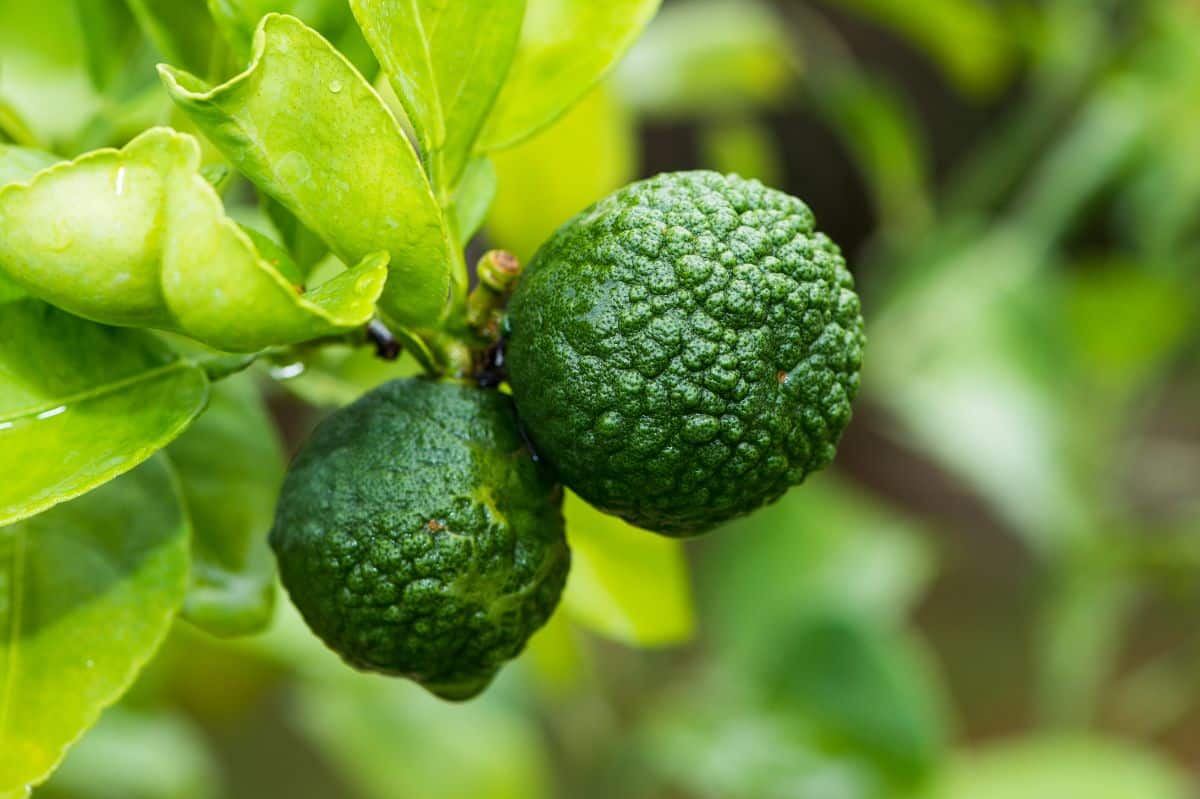
| Plant name: | Kaffir lime |
| Lighting requirements: | Bright light |
| Watering requirements: | Moderate |
| Fruiting time: | Spring through fall |
| Growing zone: | Zones 8 to 12 |
Also known as a lime leaf, kaffir limes are most often grown for their flavorful leaves that can be cooked into many Asian dishes, like Tom Yum soup. This tree’s fruit is also edible, but most cooks avoid using it as the taste is rather unpleasant. The fruits’ rind is often grated into curries and other dishes for a zingy, lime flavor though!
Kaffir lime leaves are segmented and glossy with a tart, lemony flavor, while the plant itself sprawls and spreads quite rapidly. When kept in pots, dwarf kaffir lime trees will grow between 3 and 5’ high. Just keep in mind that these plants don’t tolerate cold well, so if you keep your houseplants outdoors during the summer, be sure to bring your kaffir lime tree back inside at the first sign of chilly air.
9. Apricot
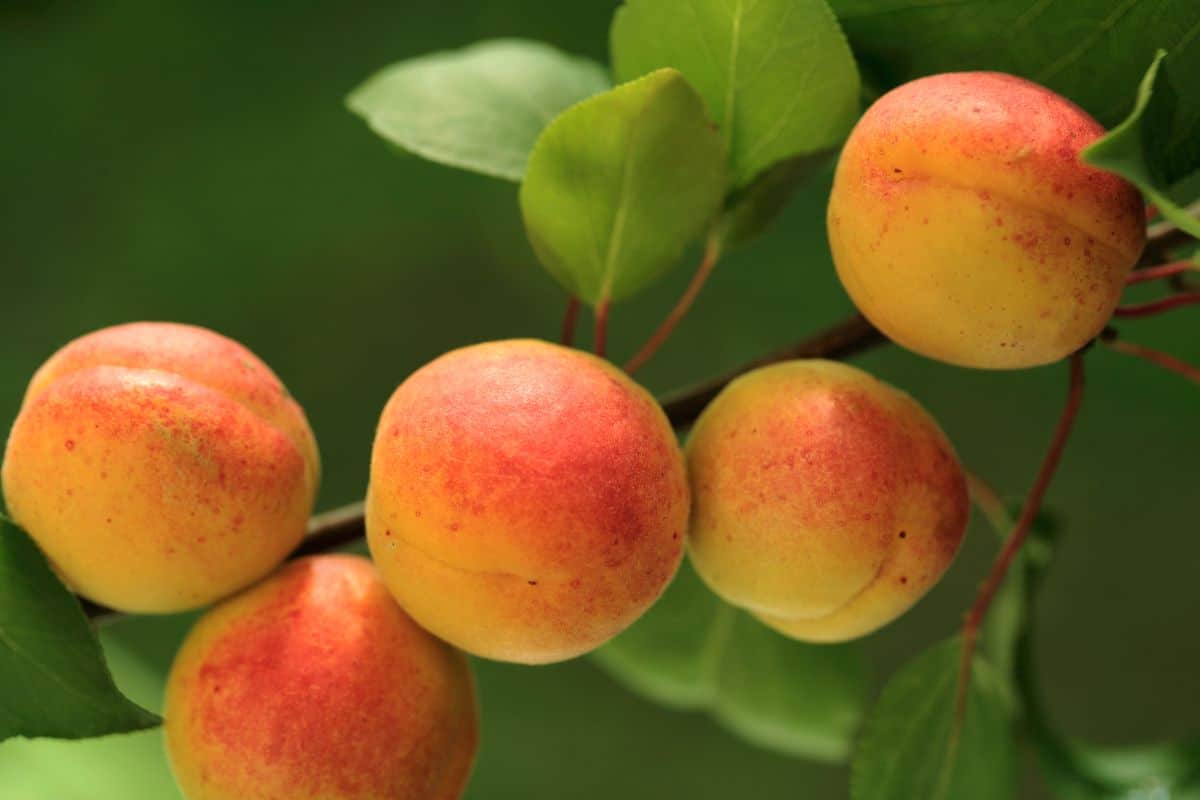
| Plant name: | Apricot |
| Lighting requirements: | Bright light |
| Watering requirements: | Moderate |
| Fruiting time: | May through July |
| Growing zone: | Zones 4 to 9 |
Sweet and succulent apricots can be eaten fresh or dried, and they’re fun to grow inside too! To keep your tree from getting too large, look for dwarf apricot varieties for indoor growing, such as ‘Goldcot’ and ‘Moorpark.’ These plants should be planted in pots that aren’t much bigger than the root ball, and they need to be watered regularly, so the soil doesn’t dry out.
If you purchase an apricot tree from a nursery, you can expect to start harvesting tasty fruit within the first year or two. For a more budget-friendly option, you can also start your own tree from an apricot pit, but it will take longer for your tree to fruit. Either way, when planting your apricot, choose a soil that is nutrient-rich and loamy and mix in a bit of compost to provide your tree with a little extra nutrient boost.
10. Key lime
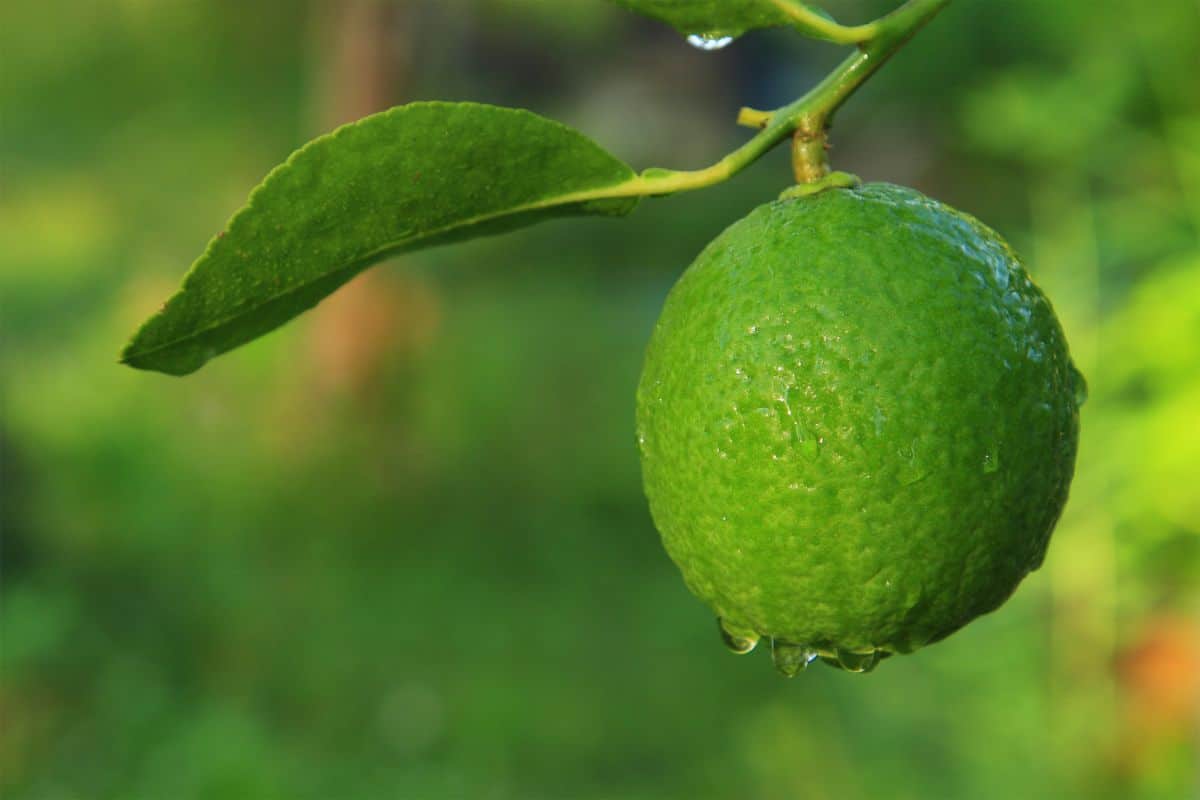
| Plant name: | Key lime |
| Lighting requirements: | Bright light |
| Watering requirements: | Moderate |
| Fruiting time: | June through September |
| Growing zone: | Zones 9 to 11 |
If you love key lime pie, why not try growing your own key limes? Finding key limes at the grocery store can be tricky; however, keeping your own tree inside will provide you with plenty of fresh fruit for pies, homemade ice cream, and other sugary delights. Look for dwarf key lime varieties, which will stay around 6’ tall, while full-sized key lime trees generally grow too fast to manage indoors.
Key limes are highly aromatic and more delicate than standard limes. Also known as bartender’s limes and Mexican limes, key limes should grow well as long as temperatures remain above 60ºF. Like other citrus trees, key limes can benefit from a regular application of a quality fertilizer suitable for citrus plants.
11. Loquat
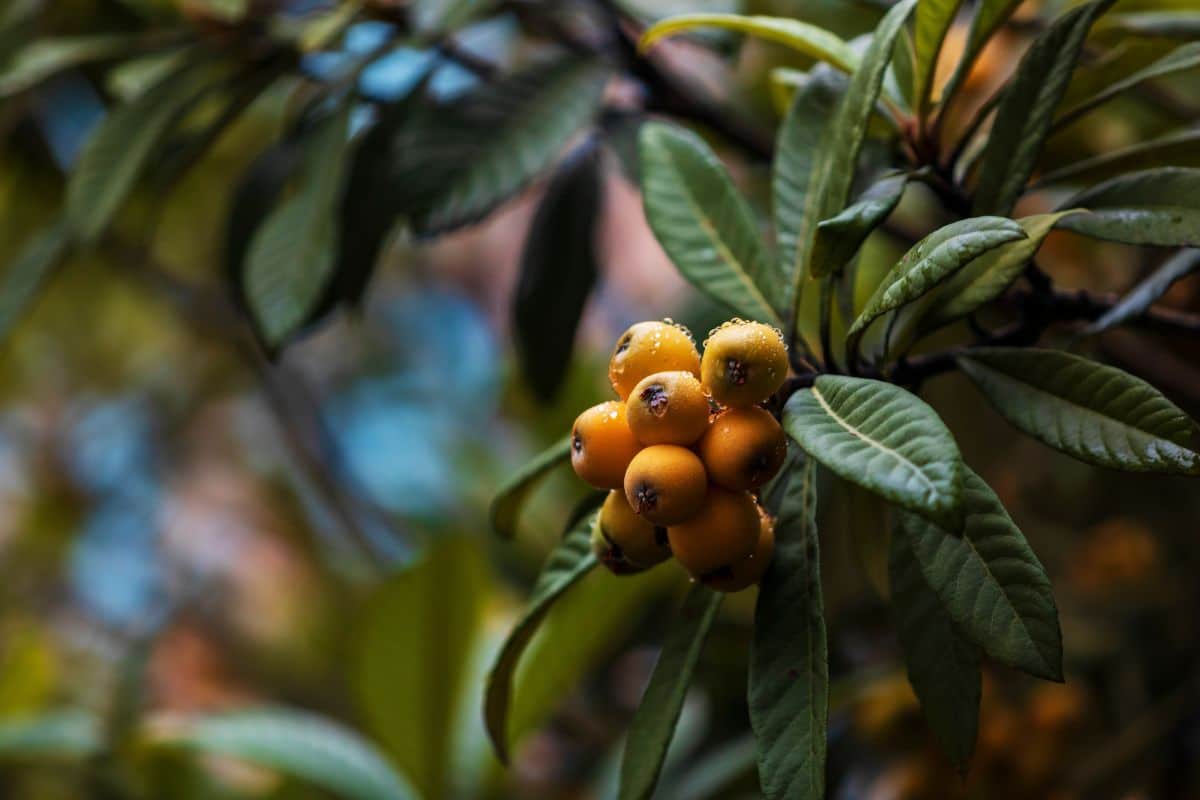
| Plant name: | Loquat |
| Lighting requirements: | Bright light |
| Watering requirements: | Moderate |
| Fruiting time: | October through February |
| Growing zone: | Zones 8 to 10 |
A good choice if you’re looking for something a bit different, loquats are evergreen shrubs that are native to China and are members of the rose family. These fruiting plants are known for their luscious orange fruit that’s sweet and tangy with notes of citrus. Just make sure you harvest your fruit when it is fully ripe and slightly soft, as immature loquats can be quite sour.
Loquats can be grown outdoors to zone 9, but in colder spots, they should be overwintered indoors. Dwarf loquats can also be purchased, which don’t grow so vigorously and are easier to keep indoors all year round in pots. Just remember to give your tree plenty of bright light to maximize your fruit yield.
12. Dwarf banana

| Plant name: | Dwarf banana |
| Lighting requirements: | Bright light |
| Watering requirements: | High |
| Fruiting time: | Year-round |
| Growing zone: | Zones 10 to 11 |
One of the most popular tree types to grow indoors, banana trees lend a very tropical look to houseplant collections with their oversized and glossy leaves. While most banana trees have solid green leaves, for truly spectacular foliage, try to find a variegated banana tree. These plants produce bananas, but they also have contrasting white and green leaves that are absolutely stunning.
Not all banana trees produce edible fruit, so make sure you know which kind of banana tree you’re purchasing. For best results, look for dwarf banana tree cultivars, like ‘Super Dwarf Cavendish’ or ‘Super Red.’
Banana trees like light and fluffy soil that’s packed full of nutrients. Because of their oversized leaves, banana trees require frequent watering and a monthly dose of good-quality, organic fertilizer. Banana trees also need 50% or higher humidity, so if your home is dry, try adding a humidifier or pebble tray to your plant’s setup.
Frequently asked questions

There are a number of different fruit trees that will grow well inside; however, to avoid overwhelming your space with a massive tree, look for dwarf varieties. Some of the best fruit trees for indoor growing include dwarf kumquats, dwarf Meyer lemons, and dwarf banana trees.
Meyer lemons are some of the easiest fruit trees to grow inside. These plants stay relatively small and produce reliably. They also are more flexible about their growing requirements and don’t need as much humidity as some other fruit tree types.
Certain tree species can be grown indoors, and that includes fruiting trees. Dwarf fruit trees are usually the best choices for indoor growing since they will stay much smaller than standard fruit trees.
Due to their small size, dwarf kumquat trees can grow well indoors and make attractive potted plants. Just provide your kumquats with plenty of bright light and regular watering, and they should grow quite happily.
Summary
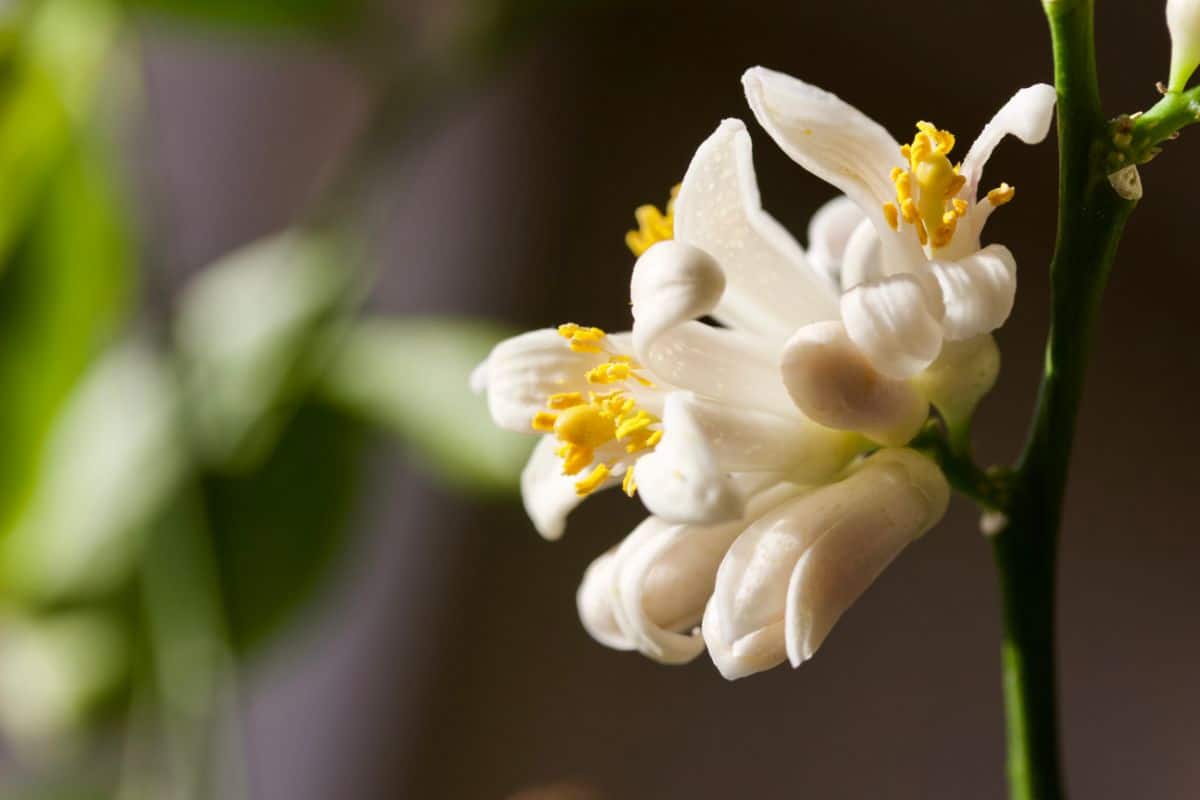
Many gardeners that live in small spaces or cool climates don’t think about growing fruit trees. However, some tropical fruit trees are available in dwarf sizes that do well indoors. These plants can be treated like many other tropical houseplants, but with an added bonus of delicious fruit!
From kumquats to loquats, growing fruit trees inside can be a fun and rewarding experience for the whole family, to enjoy. But if indoor growing isn’t for you, check out this article on growing fruit trees in your garden.

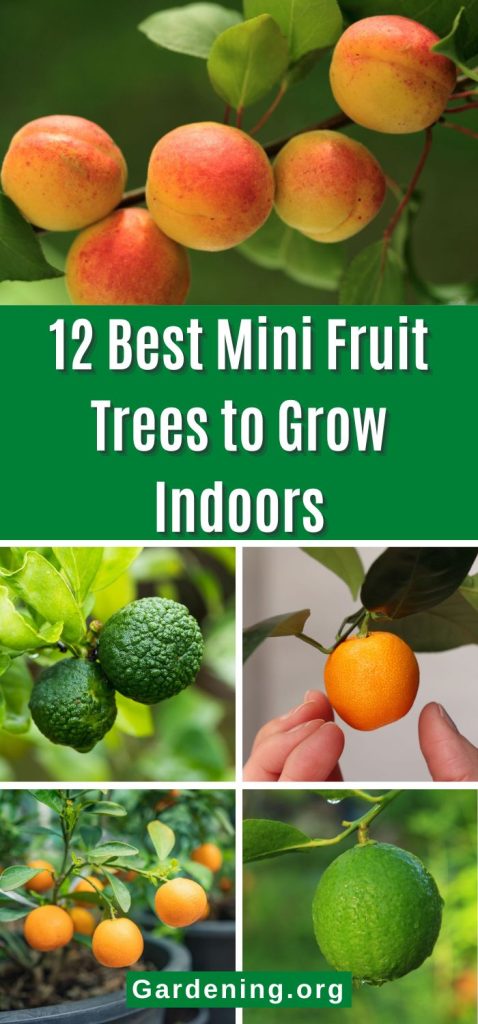

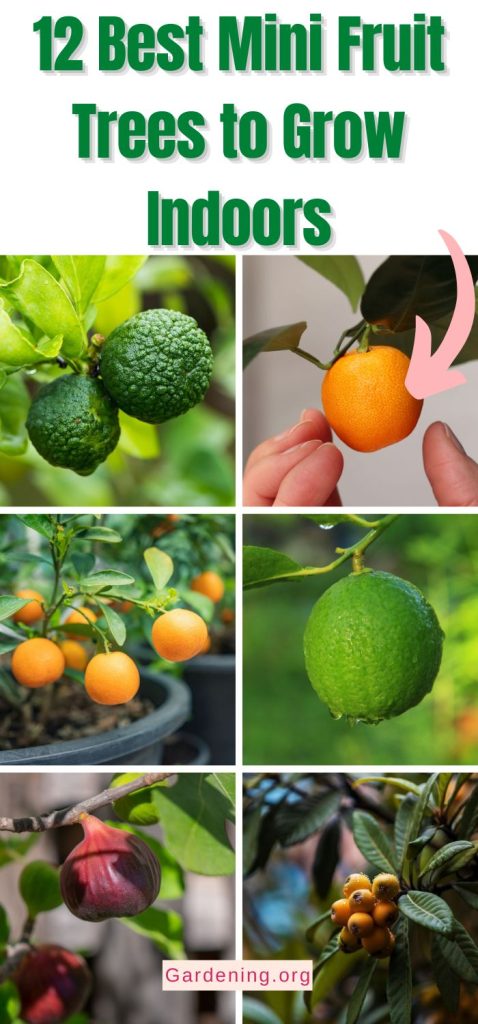
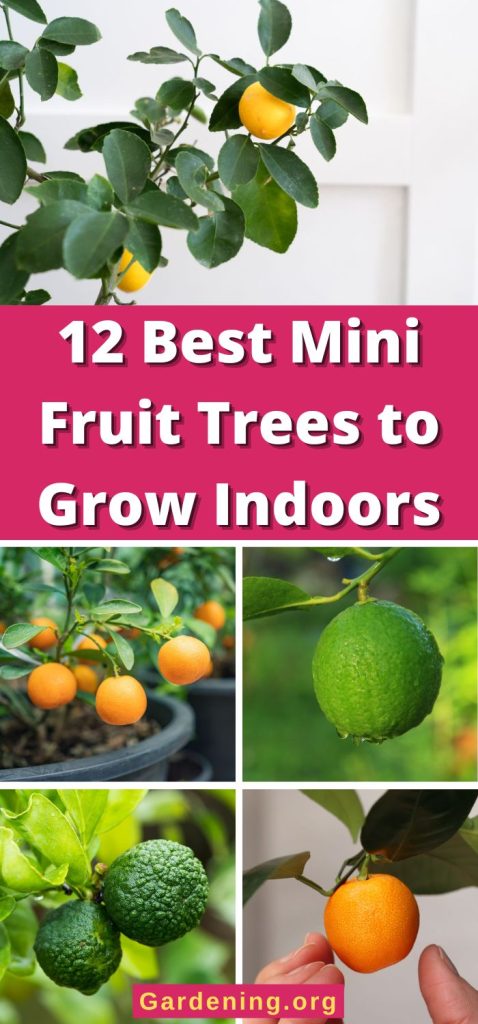
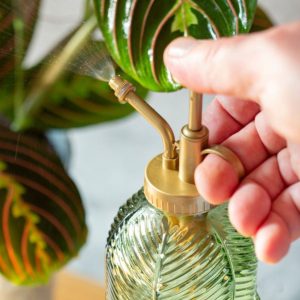
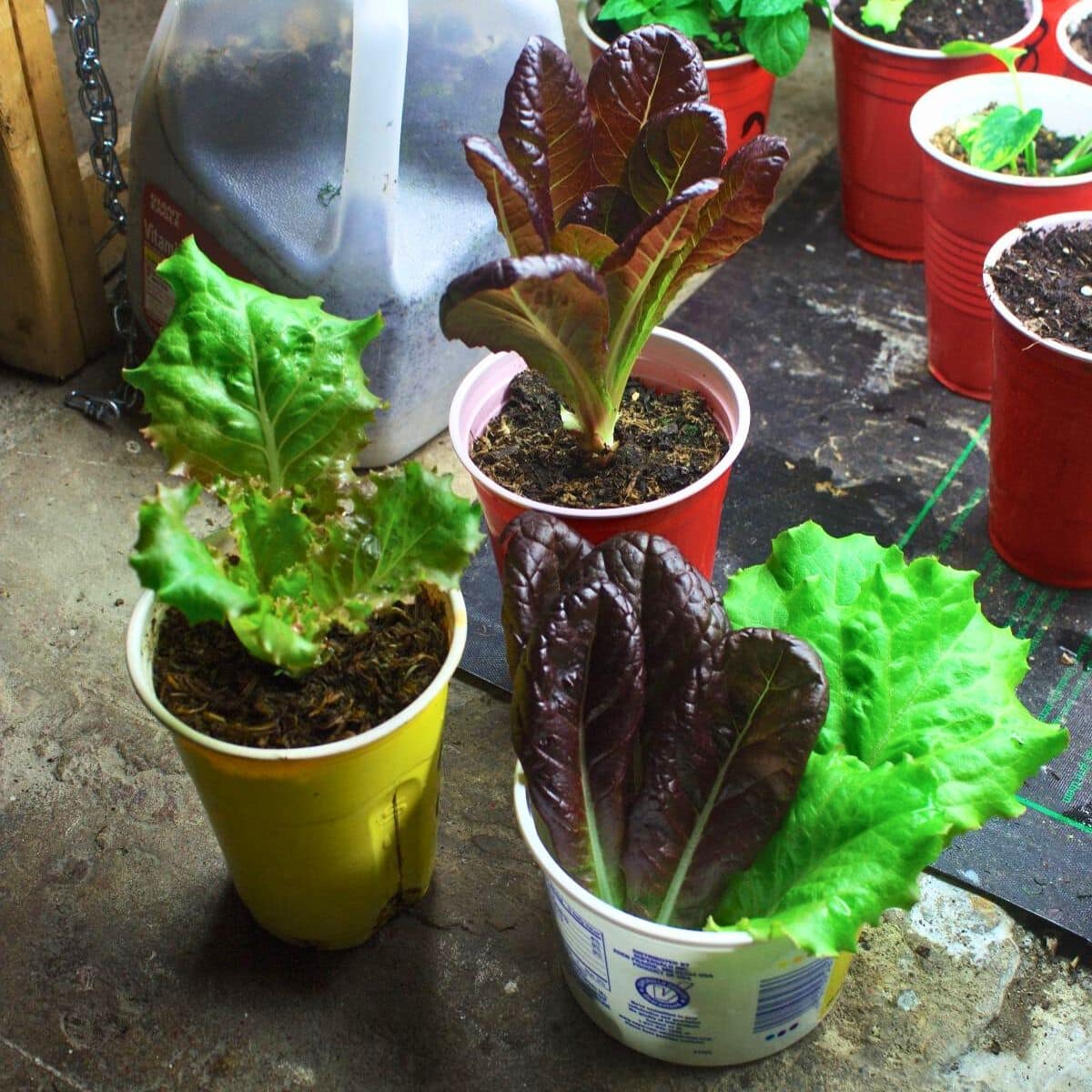
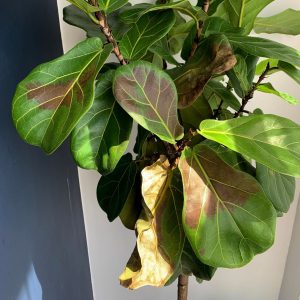

Edwin Chu
will a grow light suffice in place of "bright light"
Mary Ward
It should if it is close enough and strong enough. You may have to do some experimenting, but yes.
Demi
I have few and different kinds of dwarf lemon trees already, l would like to buy other varieties also. Do you sale some? Sent me a list of what you have and the prices. Thanks.
Mary Ward
We are an informational site and do not sell directly, but we try to provide links when we can. Please see if there are links in the article that appeal to you.
Carolyn Pulju
I have been looking for these plan yes…have perfect spot_